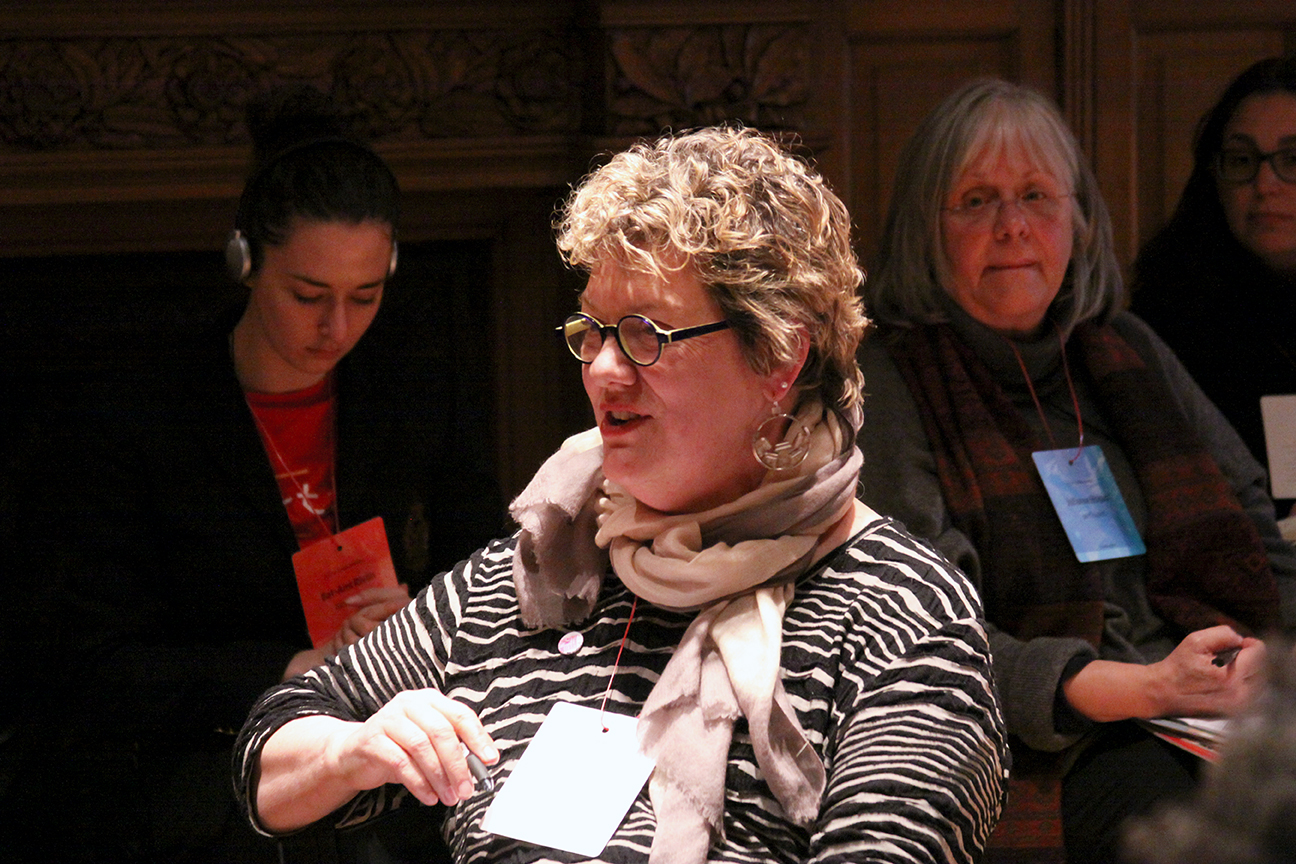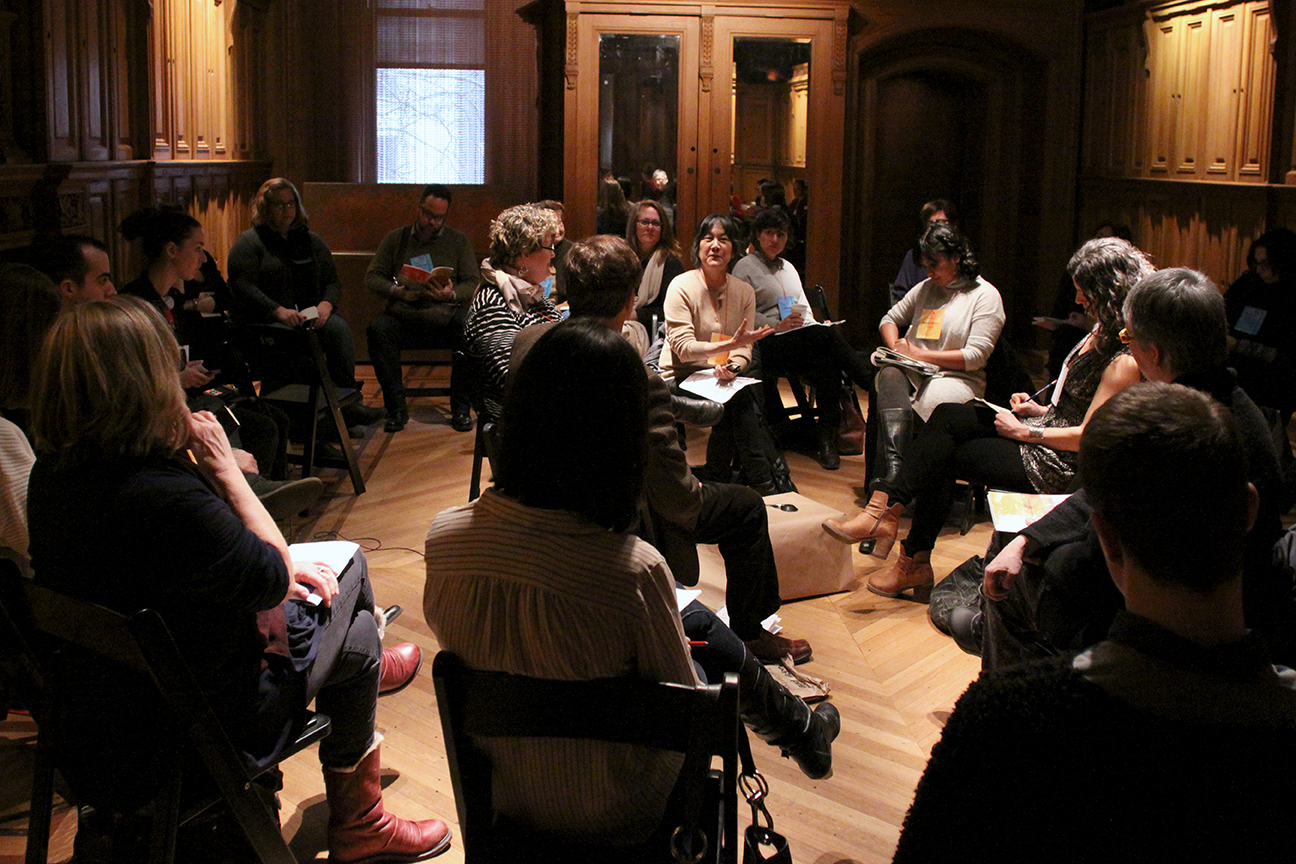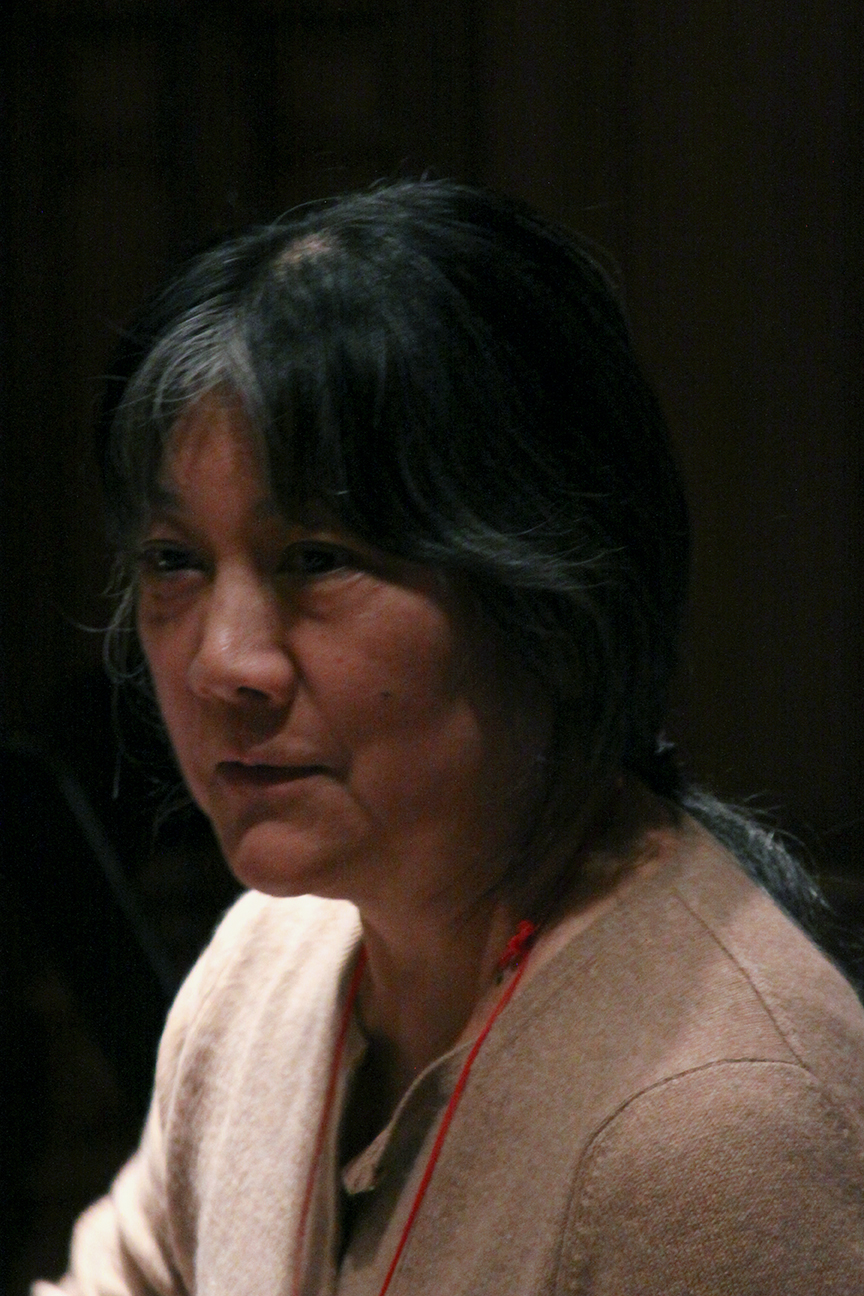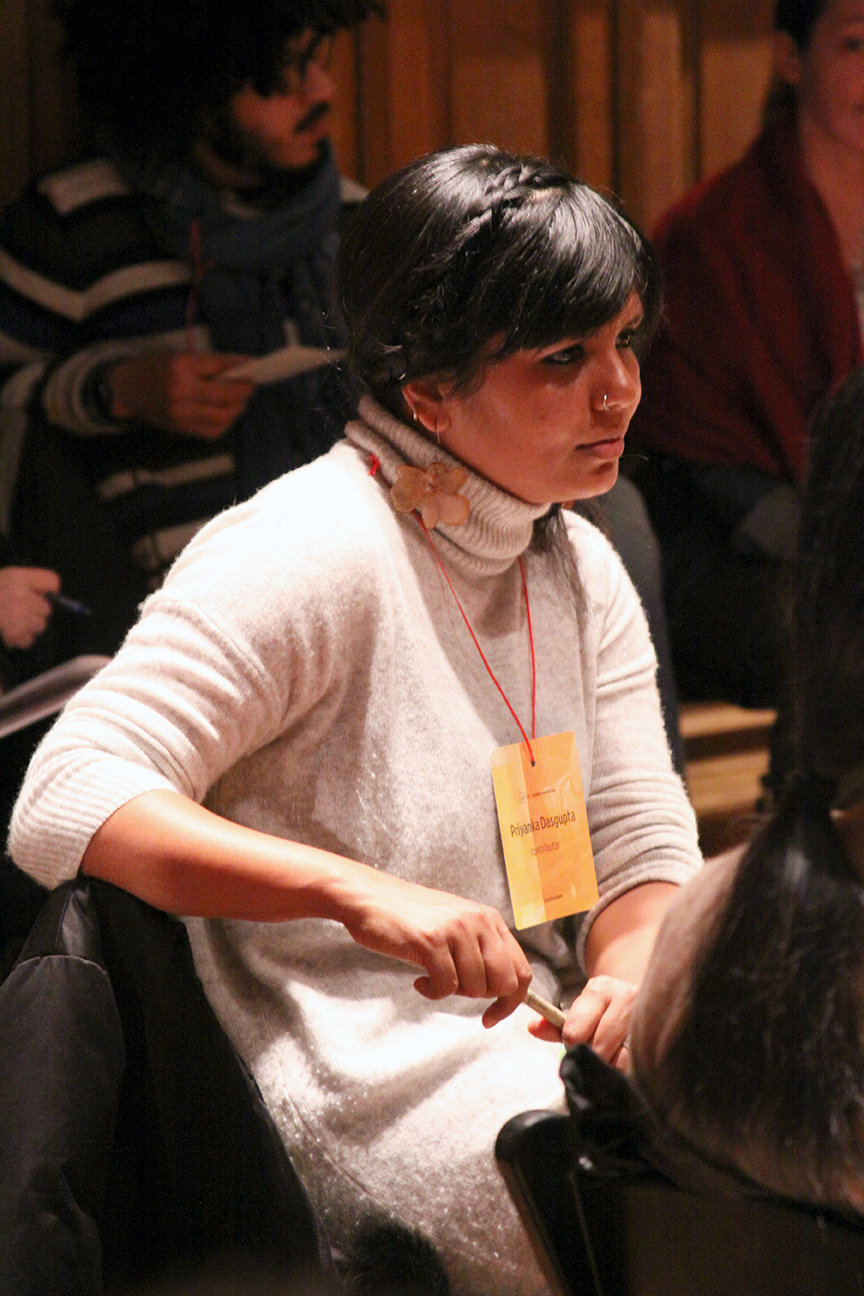The Intersections of Artistic and Educational Practices
Dialogue
In these dialogues, a moderator sat down with four discussants to delve deep into specific issues surrounding contemporary art education. The audience and discussants were encouraged to visit two separate dialogues, so a different group of artists, art educators and art professionals contributed to the first and second parts of the discussion.
The Intersections of Artistic and Educational Practices dialogues were moderated by Lois Hetland, Professor and Chair of Art Education at Massachusetts College of Art and Design. Trained in music and visual arts, Lois taught elementary and middle school students for 17 years. Now she teaches arts-based curriculum, studio-practice-while-teaching, and a travel course to India exploring art-science connections. She is also a Senior Research Affiliate for Harvard Graduate School of Education’s Project Zero.
Part 1
In the first session of The Intersections of Artistic and Educational Practices, moderator Lois Hetland asked the panel to describe their own experiences in weaving together art and education. Following the discussion, the audience broke into small groups to examine the issue further before reconvening to consider the current education system’s limitations, the value of creative processes in education, and the ways in which educational policies are in desperate need of change.
Discussants:
- Luis Camnitzer, Artist—New York, NY
- Nick Kozak, Artist, Educator, Manhattan/Hunter Science High School—New York, NY
- Dipti Desai, Associate Professor and Director of the Graduate Art + Education Programs, New York University—New York, NY
- Cathleen Lewis, VP of Education and Programs, Museum of Art and Design—New York, NY
Art and education intertwined
What is the relationship of art to education?
Luis Camnitzer: I don’t see any difference between education and art, although there is a classification of distinct disciplines. Education that is not creative is bad education, and art that is not educational is bad art. So by separating [the two], it’s the wrong question. By separating the issues you’re already biasing the division into disciplines that shouldn’t exist.
Cathleen Lewis: I’m both an artist and an administrator in a museum. I was trying to figure out where the art object starts and where it ends, and I think it really is seamless. When I create something, I’m creating it for myself in the larger culture, and I hope it will be a tool for people to learn something about the society in which we live in. When I talk about work and have the object in front of me in a museum, I want it to resonate the artist’s intent: what are they looking to say, what are they sharing?
Nick Kozak: I think that classrooms might be where art and education have some degree of separation. As a practicing artist and a practicing educator, I don’t feel like my creative process, as an artist, is limited in any kind of bureaucratic way. But as an educator, I feel like that is the case. I teach art, and that’s one of the most open subjects at the public school where I teach. The other teachers for the most part are very much bogged down by that bureaucracy, and that’s where that separation becomes very evident.
Cathleen Lewis: There are things that [teachers] have to make happen in their classrooms, and they’re reluctant to give up that time and space to art practice because they feel that it doesn’t actually meet those criteria… I think that if educators learn more about contemporary artistic practices, that it would help with a lot of that. To see the creative thinking and problem solving that occurs when you’re making art is what people want to see happening in the classroom. But some people just don’t make the connection to art.
Inspiring change
How can art education cultivate necessary and productive change?
Dipti Desai: I think one of the concerns I’ve been having, as somebody who has run a teacher-training program for art teachers for 16 years now, is what I’ve been calling regimes of vision. In the sense that I think increasingly, in education, in art, and in the media, we’ve learned to manage and control how we see and what we see. So it’s what I’m calling the management of vision, of how to look. We train people to look in a certain way. I’m constantly thinking about what my role is in perpetuating these regimes of the visible that make certain things visible and other things invisible. So as LaToya [Ruby Frazier] was saying, today, as a culture, we have systematically erased many histories. Some groups of people are visible and many groups of people are not. And education perpetuates that visibility and invisibility.
Nick Kozak: Instances where non-arts individuals in education get to collaborate with the arts… is scary for some… In the end, [collaboration] helps create courage, and maybe also fosters a greater sense of respect for things that don’t have clearly defined solutions or clearly defined outcomes, so to speak. Which is, I think, a big hurdle for a lot of educators – and people in general – to overcome. Walking into any kind of museum or gallery, seeing something on the wall or on the floor that’s unfamiliar to you, you have to “collaborate” with that artist… to take that step and gain the courage to deal with it.
Lois Hetland: How do you dismantle a system? …It’s like this process of conservative change that an organism has, where a cell doesn’t change everything at once or the cell will die. We’ve got that problem, but at the same time, we have a whole lot that has to change. So how do we change? How do we get on a pathway where we can change a little bit so that we don’t die, but keep on changing a little bit and keep on changing, moving toward a better future?
…Policy is not my place. I want to get my hands dirty. I want to be with people. I want to make stuff. I want to make relationships. And over the course of my career, it has increasingly become clear that we all have a responsibility to pay attention to policy, to the bigger picture outside of the stuff that we love so much.
I think when we’ve got people who are trying to commodify education and see it as a place that is a great resource to make money for them and their rich friends, I think we have real trouble, and I think those of us who are knowing, down at the grassroots, can’t be silent.
Part 2
In the second session of The Intersections of Artistic and Educational Practices, moderator Lois Hetland began by asking the panel to consider the value of joining art with education. After breaking into smaller discussion groups, audience members and panelists reconvened to speak about accessibility, language, and the need to close the gap between artists and their processes, and the viewer.
Discussants:
- Dillon Paul, Media Art Teacher, Flushing International High School; ART21 Educator—Flushing, Queens, NY
- Dr. Jerry James, Director of Teaching and Learning, The Center for Arts Education (CAE)—New York, NY
- Priyanka Dasgupta, Artist/Educator—New York, NY
- Tomie Arai, Artist—New York, NY
Deriving value
What you see as the value added for contemporary artists in understanding educational practice, or vice versa?
Tomie Arai: I feel that teaching is very much embedded in my work and all the projects and collaborations that I’ve done. I’m very interested in creating work that’s site-based and that’s a form of placemaking. It really is a challenge to learn about the places in which I make the work, to engage with communities that will be living with this art. I did a mural memorializing the African Burial Ground [National Monument] in Lower Manhattan, and it required that I work with all kinds of people from historians and community activists to students at Howard University who were doing research on the bones that were uncovered at the burial site. I feel like all these projects are ways for me to both learn and teach, and spaces to meet people halfway.
I don’t feel like I’m entering into these projects as some kind of sole authority. I feel much more comfortable seeing it as dialogues or conversations with people. But I come from a time when the work that I did was called “community art.” Because of the hidden histories that I wanted to reclaim and bring to light, I did a lot of oral history. It’s important that this educational component is of value not only to the people I work with but to me as well.
Priyanka Dasgupta: I don’t think I have any control over [my artistic practice]. I just have to follow along. In order to sustain the art practice in a realistic fashion, I’ve had to really understand how my making process can translate into a teaching practice so that I feel like I’m not having two separate conversations. Teaching has become an intrinsic part of my practice in the sense that my art practice is still very solitary; I still work on my own in my studio. I don’t work as much with the outside community. I feel like a lot of the practices that I employ in the classroom, as ways of teaching or understanding or creating empathy for community and culture, resonate with the way that I make my work as well.
In terms of the making, a lot of my work comes from resistance to the society of the spectacle, where everything is commercialized. As a result, I consciously work with video installation and photography – media that is employed to control us – in order to create work that then manipulates time in the opposite manner and forces the audience to slow down and reflect. That’s something that I bring to the classroom as well: creating a system in which there is a strong investment in understanding who we are and our place in our environment, and then finding ways to respond and reflect, and interact, from this place towards a real community.
Introducing contemporary art
As contemporary artists, are you seeing value added from education, or from the need to educate?
Tomie Arai: I feel like the challenge is to know when to teach and when to listen. I feel very strongly that people want to know and learn about art. It’s something that’s been mystified in our culture. When I was painting murals on the Lower East Side, the most important and rewarding experiences were standing on the street talking to people or knowing that people were watching me work.
I do feel like there are skills that artists can share that are very important to the process of making things, and that it’s not just the ideas that we’re bringing but rather some understanding of how these things go from ideas to a finished project. Not that they have to be completed, but that there’s this process that’s so important in both the classroom and the studio that you have to work through. We’ve been talking a lot [today] about failure; that is a very important element of any artistic process.
Dillon Paul: I teach in a network of schools that are all dedicated to teaching immigrant students, and I would say the majority of our students are also living in some degree of poverty or quite close to it. The questions that come up for them most often when we go to a museum are, one: “How much did this cost for them to make it?” and two: “Couldn’t that money be better spent on social programs, or food and water for people who need it?” It always puts me into this conundrum about contemporary art that’s viewed in museum settings in particular. What is the meeting place between my students who have their lens, and the contemporary artists who very well could come from a very similar background but are not understood by the students?
…If they understand the process of making artwork, I think there is so much contemporary art that’s rooted in experience, that’s rooted in materials that are important to people’s lives and that come from perhaps their childhood or their observations of a space that they lived in – [that] a student could relate. We need to know how to ask the right questions so that students can feel a kinship with the artist rather than this distance: “You’re getting paid thousands of dollars. Your artwork is excessive and ‘over there,’ whereas my experience is real and tangible and ‘over here.’”
Jerry James: When I grew up in Virginia the three R’s were reading, writing, and arithmetic. And now the three R’s are reflection, research and revision. If schools knew how much research went into making [artwork] that’s good, or how many iterations a performance art piece or an installation piece or even a watercolor goes through, then I think that would add value to schools. Especially for arts teachers, because I do find when I go to schools – whether they feel the pressure from above or wherever it comes from – a lack of resources. A lot of the things that are taught are not contemporary art. It’s the same stuff I learned when I was in school, many, many years ago.
Lois Hetland: I do think that contemporary artistic practices could be models for how people work in schools, and it’s not often understood that way. We could start from the contemporary and then reach back into history, toward the tools and skills. You can teach skills by starting with concepts, and you can teach history by starting with the present. People somehow think that if you’re talking about contemporary art, you’re saying we don’t need skills and we don’t need history.
Priyanka Dasgupta: A lot of times, we’re not given the language of appropriation, juxtaposition, layering, and re-contextualization, which are central to a lot of contemporary artistic practices and [the source of] meaning. I think equipping our teachers with that language will also make them more comfortable with bringing that work into the classroom and then having the tools to deconstruct it. Then students [can] really understand that their place in the world is as important, because those are the tools that the artists themselves employed in creating the work, layering their own experience with history, with politics, and then making work from there.
Moderator’s dialogue reflection
I was excited to try an “interactive fishbowl” structure, where the panelists talk to each other and then each facilitates a conversation with the small group sitting behind her or him. I anticipated some “star quality awe” from participants toward the artists and wanted to ensure that everyone spoke and was heard and validated as a contributing member of the dialogue: I think we accomplished that.
I also was concerned that the conversation might stay at a surface level where we all agree, so I asked participants to focus on the knots – a term I first heard from Tiziana Filippini, Pedagogista [a specialist in education theory] from the Reggio Emilia Learning Centers in Italy. Knots are the areas where we feel puzzled, confused, and possibly resistant.
The recognition of tensions between artist practices and the contexts of schooling became a central issue: how can we use practices of creative, divergent, process-oriented thinking in the setting of schools which are so constrained by accountability mandates? I was really glad that we had artists and teachers and administrators in the group – shifting perspectives among them made the discussion lively and surprising.
We began a conversation that felt open about a dilemma where every solution leads to a different compromise and no solution solves everything – so we need to inch our way forward on a number of fronts over time. I hope there are chances to continue this conversation from these diverse perspectives in ongoing ways.
– Lois Hetland
Saturday, February 21st 2015
11:45 a.m. / 1:30 p.m.



When I create something, I’m creating it for myself in the larger culture, and I hope it will be a tool for people to learn something about the society in which we live in.
— Cathleen Lewis

I think when we’ve got people who are trying to commodify education and see it as a place that is a great resource to make money for them and their rich friends, I think we have real trouble, and I think those of us who are knowing, down at the grassroots, can’t be silent.
— Lois Hetland

I’m very interested in creating work that’s site-based and that’s a form of placemaking…
I feel like all these projects are ways for me to both learn and teach, and spaces to meet people halfway.
— Tomie Arai

In terms of the making, a lot of my work comes from resistance to the society of the spectacle, where everything is commercialized.
As a result, I consciously work with video installation and photography – media that is employed to control us – in order to create work that then manipulates time in the opposite manner and forces the audience to slow down and reflect.
— Priyanka Dasgupta
I do think that contemporary artistic practices could be models for how people work in schools, and it’s not often understood that way…
You can teach skills by starting with concepts, and you can teach history by starting with the present.
— Lois Hetland


